Physical Address
304 North Cardinal St.
Dorchester Center, MA 02124
The spectrum of virally associated B-cell lymphoproliferative diseases is broad, ranging from reactive lymphadenitis to lymphomas. Often the reactive processes can be diagnostically challenging and mimic lymphomas due to a combination of direct viral effects and indirect ones mediated by the immune system.
In this chapter, we focus on gamma herpesviruses, namely Epstein-Barr virus (EBV) and Kaposi's sarcoma-associated herpesvirus (KSHV), also designated as human herpesvirus 4 (HHV-4) and human herpesvirus 8 (HHV-8), respectively. Both gamma herpesviruses (EBV and KSHV) can infect B lymphocytes and establish a latent infection in which no viral progeny is usually produced and only a limited number of genes are expressed. Chapter 30 deals with virally associated T-cell and NK-cell lymphoid proliferations.
An increased risk for developing EBV-related lymphoproliferative disorders/lymphomas is also present in individuals with primary or secondary immunodeficiencies. This increased risk appears to be due the inability of the immune system to handle the viral infection either due to intrinsic defects of T cells, NK cells, or NKT cells or due to immunosuppressive regimens such as in the posttransplant setting (posttransplant lymphoproliferative disorder [PTLD]). EBV-related lymphoproliferative disorders in the context of primary or secondary immunodeficiencies are addressed in Chapters 54 and 55 .
Well-defined lymphoma entities such as Burkitt's lymphoma, classical Hodgkin's lymphoma, and plasmablastic lymphoma that are associated also with EBV are discussed in separate chapters.
EBV-associated lymphoproliferative disorders have a worldwide distribution. EBV is orally transmitted, and the majority of the population is infected early in life (>90% positive by 5 years of age). When the primary infection occurs in children, it is usually asymptomatic or it is a self-limited viral illness. In the United States and other countries with similar economic development, the primary infection tends to occur in early childhood less frequently (40% to 65%); when it occurs in early adulthood, it can be more symptomatic, causing acute infectious mononucleosis (AIM) (35% to 50%). Most AIM cases resolve without sequelae within a few weeks, but some patients will have a more protracted clinical course. Distinction between protracted AIM and the development of chronic active EBV (CAEBV) is sometimes difficult and requires clinicopathologic correlation with EBV serology and repeated viral load measurements.
The original description of chronic active Epstein-Barr virus of B-cell type (CAEBV) by Dr. Straus referred to a chronic or persistent EBV infection characterized by severe illness lasting more than 6 months, persistent elevated EBV titers, and evidence of EBV-related organ damage. Based on the Western experience, it was thought to be due to persistent activity related to EBV in B cells. However, later the term CAEBV was used to identify similar clinical syndromes occurring in Asian patients involving predominantly EBV infection of T cells and NK cells.
Currently, CAEBV is defined as (1) a severe progressive illness of more than 6 months' duration, usually with fever, lymphadenopathy, and splenomegaly that either began as a primary EBV infection or was associated with markedly elevated antibody titers to EBV viral capsid antigen (VCA ≥1 : 5,120) or early antigen (EA ≥1 : 640), or markedly elevated EBV DNA in the blood; (2) infiltration of tissues (e.g., lymph nodes, lungs, liver, central nervous system, bone marrow, eye, skin) with lymphocytes; (3) elevated EBV DNA, RNA, or proteins in affected tissues; and (4) absence of any other immunosuppressive condition.
Based on this definition, only a few CAEBV cases of B-cell type have been described in the Western world, and according to Kimura and colleagues, only 3% of CAEBV diagnosed in Japan are of B-cell type.
In the United States, CAEBV-B occurs at a median age of 23 years, which is older compared with T/NK-cell type CAEBV patients (median, 7 years of age). Although the presenting symptoms are similar, CAEBV-B tends to present with lymphadenopathy and splenomegaly; but fevers, pancytopenia, and hepatitis are also observed. In contrast to T/NK cases, these patients develop progressive hypogammaglobulinemia, often later in the course of the disease. Interestingly, CAEBV-B patients also have low CD19-positive cells, as well as low NK cells and T cells (CD4 and CD8), suggesting the possibility of an underlying genetic defect involving cellular immunity. Genes commonly involved in EBV control, such as SAP, 2B4, SLAM, NTB-A, XIAP, as well as perforin and granulysin, should be screened for mutations. Indeed, additional genetic testing has sometimes revealed underlying novel genetic aberrations.
The cytokine profile in CAEBV-B is similar to that observed in CAEBV-T/NK. Both have Th1-dependent (TNF alpha/INF gamma) and Th2-dependent (IL6 and IL10) cytokines. However, CAEBV-B patients tend to develop a hemophagocytic syndrome less frequently (one third of cases).
Histologically, the lymph nodes often show features resembling polymorphic PTLD, with paracortical expansion, numerous immunoblasts admixed with cells with plasmacytoid differentiation, plasma cells, and occasional Hodgkin-like cells. EBV by in situ hybridization shows numerous positive B cells mainly in the expanded paracortex ranging in cell size from small to large. In some cases with multiple biopsies, histologic progression toward a monomorphic PTLD-type lesion can be observed. Sixty-three percent of tested cases had clonal immunoglobulin rearrangements.
EBV-positive diffuse large B-cell lymphoma, not otherwise specified (NOS) originally described as senile EBV-associated B-cell lymphoproliferative disorder, or EBV-positive DLBCL of the elderly in the fourth edition of the WHO classification, is an EBV-associated clonal B-cell proliferation often occurring in patients older than 50 years without any known immunodeficiency or prior lymphoma. Subsequent studies have shown that EBV-positive diffuse large B-cell lymphoma (DLBCL) is not limited to this age group, but it can also affect younger patients who do not have an underlying immunodeficiency or any other cause of immunosuppression. To reflect these observations, EBV-positive diffuse large B-cell lymphoma, not otherwise specified, was adopted in the revised fourth edition of the WHO classification.
In the elderly group (>80 years ), it is thought to be related to the physiologic aging process, during which the ability to handle viral infections is diminished. The phenomenon of immunosenescence is multifactorial, and it involves both innate and adaptive immune responses, but it remains poorly understood. Complex mechanisms and multiple factors are at play in remodeling the immune system during the aging process. These include modification of T-cell homeostasis due to lack of thymic output of naïve T cells, and accumulation of viral-specific CD8-positive T cells, including specific lifelong memory cells, which together influence the composition of the T-cell pool and reduce its diversity.
In the original description by Oyama and colleagues, EBV-positive lymphoproliferative disorder in the elderly showed striking similarities with polymorphic and monomorphic PTLD, frequent extranodal presentation, and an overall aggressive clinical behavior. The EBV-positive cells were of B-cell lineage and often expressed CD30, but lacked CD15. The majority of cases had EBV latency type II and relatively few with type III. A larger follow-up study confirmed the relatively poor overall survival in cases diagnosed as polymorphic or monomorphic, which was also inferior to EBV-negative diffuse large B-cell lymphoma. This and other studies led to the inclusion of EBV-positive DLBCL of the elderly in the WHO classification of 2008 as a provisional entity.
By definition, other well-defined EBV-associated disorders (e.g., lymphomatoid granulomatosis, primary effusion lymphoma, plasmablastic lymphoma, DLBCL associated with chronic inflammation) are not included in this category.
Originally reported almost exclusively in Japan and Korea, it has also been described in other regions (e.g., Latin America, Europe, Turkey, and the United States). It has a frequency ranging from 2% to 14%, with the lowest incidence in Europe and the highest in Japan and Latin America.
EBV positivity in DLBCL increases with age, with a peak (20% to 30%) at older than 90 years. A few studies have reported EBV-positive DLBCL in younger patients, with a frequency ranging from 6.7% to 8%.
The median age is 71 years, and the male-to-female ratio is 1.5 : 1. Extranodal presentation with or without nodal involvement is common (50% to 70%), frequently involving skin, lung, tonsil, and stomach. Based on retrospective studies, the clinical outcome is poor, with a median overall survival ranging from 24 to 36 months, even in patients treated with rituximab and chemotherapy. Unfavorable prognostic factors include older age (>70 years), high IPI, and non–germinal-center B (GCB) phenotype. However, the response rate to various chemotherapeutic regimens has not been evaluated, and prospective trials are needed.
The cohort of younger patients (≤45 or ≤50 years of age depending on studies; median, 23 years of age) shows also a male predominance, but these patients present almost exclusively with nodal disease in contrast with older adults. The clinical outcome and response to therapy is significantly better in comparison with the elderly, and most patients achieve clinical remission.
Histologically, the lymph node or extranodal sites show architectural effacement by an abnormal lymphoid proliferation, often with prominent necrosis. The infiltrate includes large cells with morphologic features resembling centroblasts, immunoblasts, Reed-Sternberg–like cells, lymphocyte predominant (LP)-like cells, and occasional highly pleomorphic cells. Several growth patterns are recognized; one is characterized by monotonous sheets of large cells consistent with diffuse large-cell lymphoma (monomorphic subtype) ( Fig. 29-1 ), and the other is characterized by a variable number of large cells in a background rich in reactive cells such as small lymphocytes, histiocytes, epithelioid histiocytes, plasma cells, and occasional eosinophils (originally referred to as the polymorphic subtype by Oyama et al. ) ( Fig. 29-2 ). The histologic appearance may resemble T-cell/histiocyte-rich large B-cell lymphoma with the neoplastic cells resembling immunoblasts or LP-cells ( Fig. 29-3 ). In other cases the neoplastic cells more closely mimic Reed-Sternberg cells ( Fig. 29-4 ). Plasmacytoid differentiation resembling polymorphic post-transplant lymphoproliferative disorder is rare.
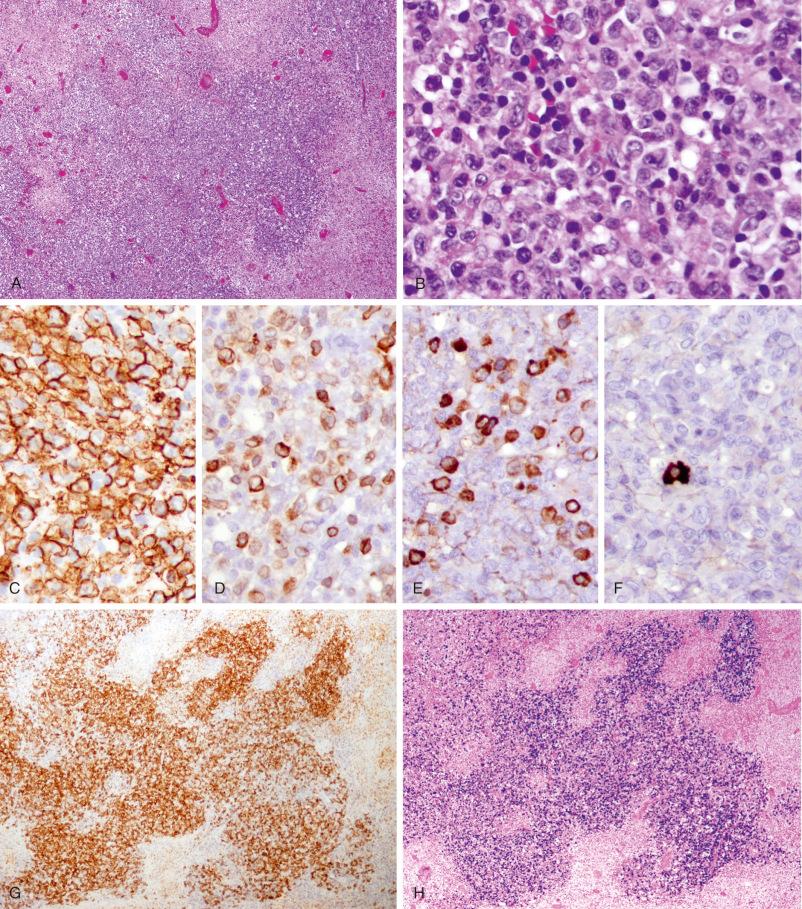
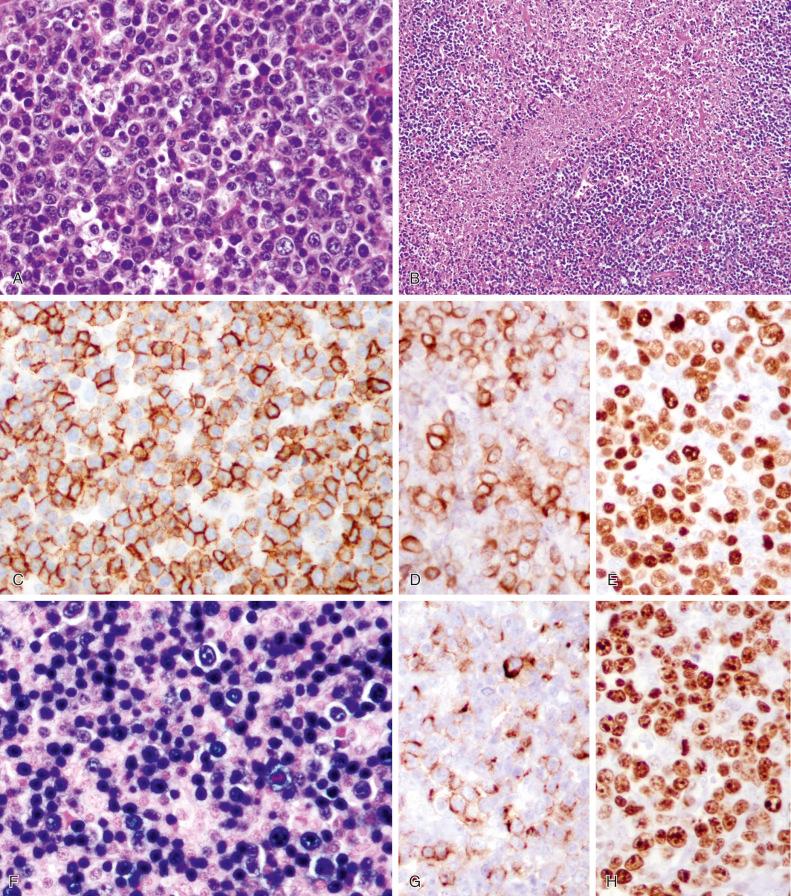
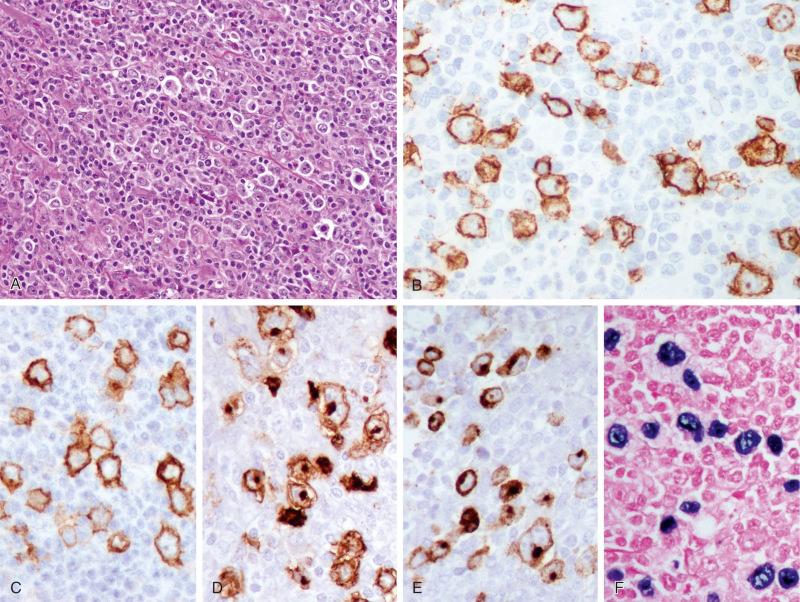
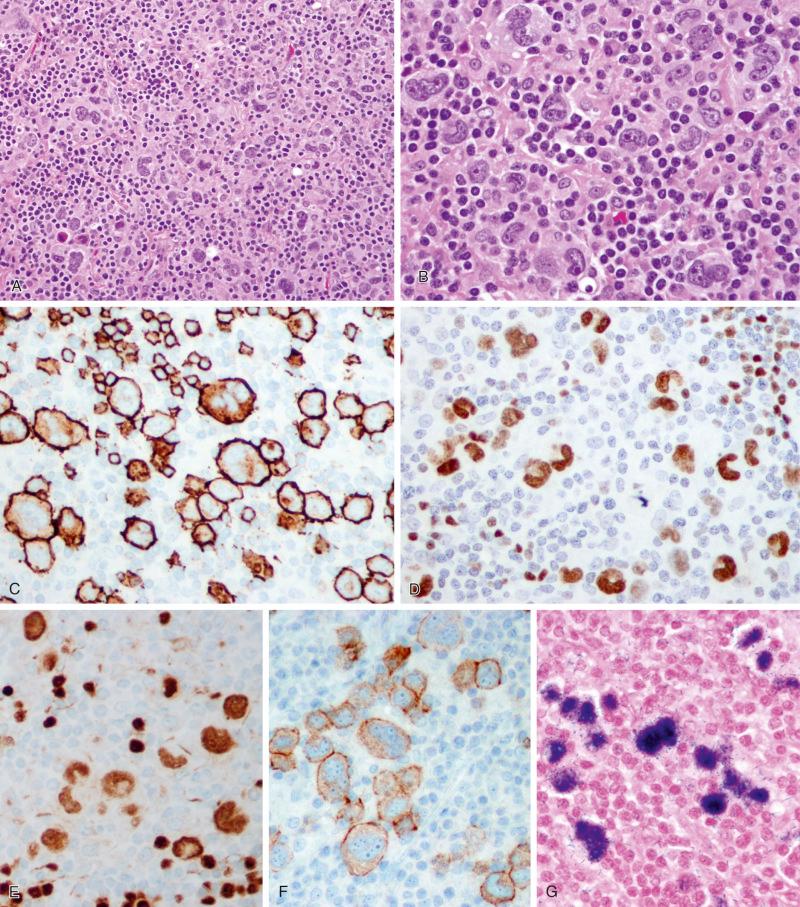
Immunophenotypically, the large atypical cells usually express pan–B-cell markers, and rare cases that lack CD20 expression still maintain a strong B-cell program as per PAX5, OCT-2, BOB-1, and CD79a (see Figs. 29-1 to 29-4 ). They tend to be of a non-GCB phenotype and lack CD10 and are usually positive for IRF4/MUM-1, with variable BCL-6 expression. Most reported cases are CD30 positive but tend to lack CD15 expression. CD15 expression was reported positive in 25% of cases in one study. By definition, the atypical cells are EBV positive, with Epstein-Barr virus–encoded RNA (EBER) by in situ hybridization demonstrated in the majority of tumor cells; however, different cutoffs as low as 20% and 10% have been used in several studies, and it is questionable whether in such cases the virus plays a significant pathogenic role. LMP-1 is expressed in the majority of cases (94%), and EBNA-2 in one third of cases (28%), consistent with a predominant latency type II. A similar phenotype also was observed in younger patients. The tumor cells frequently express PD-L1, a finding also encountered in EBV-positive posttransplant–associated B-cell proliferations. The binding of PD-L1 to PD-1 on T cells may lead to an immunosuppressive environment, preventing immune surveillance, even in patients without immune compromise.
The presence of Reed-Sternberg–like cells in a reactive background may suggest classical Hodgkin's lymphoma. In contrast to the latter, EBV-positive DLBCL of the elderly more commonly involves extranodal sites and frequent necrosis; all cases show a strong B-cell program, and in the majority of cases lack CD15 expression. This diagnostic challenge is even greater in younger patients due to their nodal disease and Hodgkin-like features in a subset of cases. The presence of RS-like cells also can be frequently seen in other EBV-driven proliferation, especially in immunosuppressed patients. Clonal immunoglobulin gene rearrangement is demonstrated in about one half of the cases tested.
Some of the EBV-positive B-cell proliferations seen in the elderly have a more self-limited condition characterized by the presence of mucocutaneous ulcers with an indolent clinical course and a high rate of spontaneous remission. This phenomenon is most likely due to a more localized form of decreased immune surveillance. Similar lesions have also been described in posttransplant patients and in the context of iatrogenic immunosuppression. It is of interest that in cases tested EBV viral load was low in peripheral blood, further supporting the localized nature of this process. In the original report the median age was 77 years (range, 42 to 101), with females affected more frequently than males.
These isolated ulcers tend to involve skin, oropharyngeal mucosa, or gastrointestinal tract. Histologically they are sharply demarcated, and the ulcer bed is lined by an inflammatory infiltrate with clusters of large atypical cells, often with Hodgkin/Reed-Sternberg (HRS)–like features. Phenotypically the large atypical cells are variably positive for CD20, strongly positive for CD30, CD15 positive in almost half of the cases, and uniformly positive for EBV by in situ hybridization. A large number of T cells is usually noted at the bottom of the lesion contributing to the sharp demarcation of these ulcers. Forty-five percent of cases regressed spontaneously. All patients with iatrogenic immunosuppression and available follow-up responded to a reduction in immunosuppression (see Chapter 55 ).
DLBCL associated with chronic inflammation occurs in the context of long-standing chronic inflammation and is associated with EBV. It usually involves body cavities or enclosed spaces (like cysts). Pyothorax-associated lymphoma (PAL) represents the prototype of this form of DLBCL.
Pyothorax-associated lymphoma is a pleura-based, mass-forming, EBV-associated DLBCL occurring in patients with long-standing infection (pyothorax) resulting from artificial pneumothorax for the treatment of tuberculosis or tuberculous pleuritis. It is a rare form of lymphoma more commonly found in Japan, but it has also been described in Western populations. The higher incidence in Japan is explained by the more popular practice of artificial pneumothorax for the treatment of tuberculosis in the past. Patients are commonly in their seventies, and there is a striking male predominance (male-to-female ratio, 12.3 : 1).
Pyothorax-associated DLBCL is consistently EBV positive and has a latency type III pattern with expression of EBNA-2 and LMP1. * It has been speculated that chronic inflammation may provide a local tolerogenic environment that allows the EBV-positive B cells to proliferate and undergo malignant transformation. There is no association with KSHV (HHV-8) in contrast with primary effusion lymphoma.
* References .
Patients have long history of chronic pyothorax and may present with chest pain, fever, cough, dyspnea, or tumor mass in their chest wall. The median interval between the onset of infection and the onset of lymphoma is 37 years (range, 20 to 64 years of age). The outcome is poor, with an overall survival rate of only 20% to 35% ; however, staging and other comorbidities have an impact on outcome. Patients with stage I disease may be cured with surgery alone.
Typically, there is a diffuse proliferation of large atypical lymphoid cells that are indistinguishable from other DLBCLs ( Fig. 29-5 ). The cytoplasm may show evidence of plasmacytoid differentiation. By immunohistochemistry, the neoplastic cells express CD45 and pan–B-cell markers. They are usually also positive for IRF4/MUM1 and CD13, while lacking CD10 and BCL6, in keeping with a post–germinal-center or late germinal-center phenotype. Occasionally, a dual phenotype with aberrant expression of T-cell markers (CD2, CD3, or CD4 in addition to pan–B-cell markers) was seen, but gene rearrangement confirmed B-cell origin.
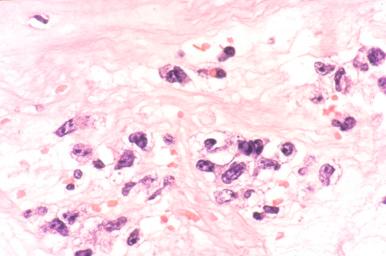
Become a Clinical Tree membership for Full access and enjoy Unlimited articles
If you are a member. Log in here